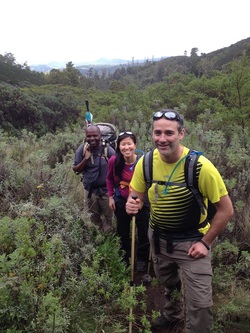Kilimanjaro Training

You must be in the
best shape of your life to climb Mt. Kilimanjaro. It is not a technical
climb, but it is extremely challenging. Not many tour operators will tell you
this, but summit night is GRUELING and it will test you, physically, spiritually, and
mentally. While trekking along any of the routes, you will easily spot the climbers
who are out of shape. They are the ones who fall behind the rest, look
miserable, and arrive at each camp much later than everyone else. They are the
ones you worry about. Yes, altitude sickness can affect anyone, at any age and every
fitness level, but those who attempt to summit Kilimanjaro without proper
training are placing themselves in grave danger. It’s true that you will be
walking very slowly, but most of this is uphill, over uneven terrain, with less
oxygen than you are used to. Add to this a pounding headache and nausea. You will not enjoy your experience if you
are out of shape.
Kilimanjaro Training Plan
First, you must visit your doctor to ensure that you are in good health and able to begin a training program. To maximize your fitness, you should incorporate the following:
Kilimanjaro Training Plan
First, you must visit your doctor to ensure that you are in good health and able to begin a training program. To maximize your fitness, you should incorporate the following:
-
You should hike at least once a week, beginning 12-16 weeks before your Kilimanjaro
climb, wearing the pack and boots that you plan to use in Tanzania. Increase your
hike each week until you are hiking 8-10 miles comfortably, incorporating hills
and uneven terrain as much as possible. If hiking is not possible, use a
stairmaster or treadmill at the gym and select a hill setting. If you cannot go
to the gym, find a lot of stairs.
- You
must include aerobic training to strengthen your heart and lungs and improve
your VO2 max (the maximum amount of oxygen, in
milliliters, your body can use in one minute). To improve aerobic fitness, exercise
at 70 to 80 percent of your maximum heart rate (defined as 220 minus your age),
for at least 30 minutes three times per week. Find a good 10K training plan or
download an app to make your exercise more fun and consistent.
- Incorporate strength training for all of your muscle groups
at least three times a week, with emphasis on legs and core body strength. You will need this extra strength to keep you
going on summit night. The descent is painful if you are not in good shape.
